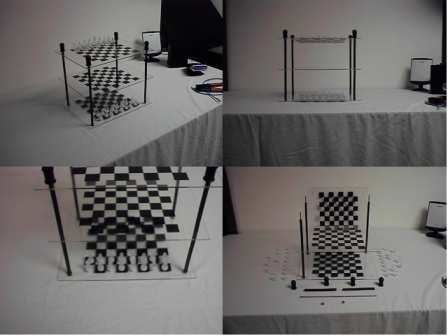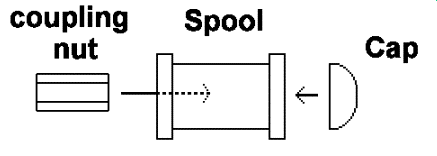

| Material Required | Sources |
|---|---|
| 4 stop nuts * | Hardware store |
| 4 12" length of 10-24 threaded rod | Hardware store |
| 4 wooden spools ** | Craft store |
| 4 wooden caps *** | Craft store |
| 4 coupling nut | Hardware store |
| 3 sheets of 11X14 clear acrylic | Hardware store |
| Acrylic paint | Craft store |
| Spray paint | Hardware store |
| Stick on felt feet | Hardware store |
| 1/4" I.D. 3/8 O.D. flexible PVC water pipe.**** | Hardware store |
| * A "stop nut" is a nut that has a mechanism to keep it from screwing on the full way | |
| ** They sell these, you don't need to buy a spool of thread and unravel it | |
| *** "Cap" is not a technical or correct term, don't go in the store asking for "caps", they won't know what you are talking about | |
| **** Again, not a technical term\name | |
The boards are made from painted 1/8" thick 11"X14" clear acrylic sheets.
The first thing that needs to be done is to drill the holes for the support to go through. The holes must be large enough for the threaded rod to go through but small enough that the support will not go thru. The hole must also be small enough that it will not be seen when the support is seated. A 7/32 hole should be fine.
On a single board measure and mark the place where the hole will be drilled, 1" from each of the corners. All three boards are then stacked and taped together. You must use a tape that will not leave any residue when taken off. On clear acrylic, residue is easily seen and very difficult to remove. Next the holes are drilled through the marked areas. All three boards are drilled at once to insure that the holes line up. One of the problems with drilling through the sheets at once is that as the drill passes through each sheet chips and melted plastic gets in between there- I just wanted to warn you!
Pull the boards apart and finish with any clean up that needs to be done. If the holes are too small they can be enlarge with a reamer.

Next the squares are drawn and painted on.
To start drawing the squares draw two guidelines (fig. 1) directly thru the
center of the board with an ultra fine point Sharpie marker. Then from these
guide lines eight columns and eight rows (fig. 2) are measured with a ruler
and drawn with the ultra fine point Sharpie marker. How big the squares are
is up to you but 1 1/8" squares seems OK. Next all the drawn lines that will
not be around black squares are removed (fig. 3) using glass cleaner and a
rag. Using a very fine brush paint all the black squares (fig. 4) with common
acrylic gloss black paint. Paint directly over the Sharpie lines. You must
use gloss paint so that it will blend with the Sharpie marks. The "white"
squares are not painted, they remain clear. Paint the squares a second time.
A third last coat is a finishing coat. Hold the board up to the light and
anywhere light shows through the black squares paint over. Repeat on the
other two boards
The supports are made of two parts- the inside threaded rod and the exterior support.
10-24 threaded rod can be bought in most hardware stores in pre-cut lengths of 12" or 36". Metal shops sell it in longer lengths. It is easy to just buy four 12" rods but you can buy and cut the rods to whatever length you wish if you want a different height board.
The exterior supports are made from 1/4" I.D. X 3/8 O.D. flexible potable water pipe. This pipe seems a little weak, but don't worry the treaded rod will stiffen it and since not a lot of weight will be placed on the supports its OK. Eight 5 1/4" sections of the tube are cut. It's best to cut them with a pipe cutter so that the ends are square.
The supports are then painted. Use spray paint to paint them. black is good because the color covers the flaws in the paint job. The best way to paint is to loop a wire through two holes in a scrap board, then bend the wire in such a way as to hold the support from the inside without allowing it to slide down on to the board.
The tops are made from three parts- a wood spool, a cap, and a hex coupling nut. You must make four tops.
First, ream out the hole of the spool so that the nut can be pushed in. The hole's size should be loose enough that the nut will push in but tight enough that it will not rotate easily. The easiest way to do this is to use a set of drills to ream the hole larger. Start with a drill that is slightly larger then the hole already in the spool, then hand turn the drill and work it through. Do the same with the next larger drill and continue till you have reached the desired diameter. This method insures that the hole remains reasonably centered. It may be better to do this on a lathe but I recognize most homes do not contain one.

Next, glue the cap to the top center of the spool. Super glue seems to work fine.
The third step is to push the nut in the hole of the spool and glue it in. Again, super glue should be fine.
Bottom
DONE!!! Top |
|
The edge of the acrylic is not pleasant to look at, the solution is to paint the edges. It can be kind of tricky. The tequniqe is to paint the edge and wipe the paint off the top and bottom surface with a rag. You must always wipe TOWARDS the edge. You should use a clean rag or clean part of the rag for each wipe. Like I said, you want to but to wipe the paint off the top and bottom of the acrlic but keep it on the edge. Of course there will still be some paint on the tier surface, this can be rubbed off with a finger nail or the edge of a penny

The chess pieces you use depends on the rules you play by. I like rules that use regular chess pieces such as Millennium Three Dimensional Chess that use regular chess pieces. Currently, glass chess sets are both plentiful and cheap. The glass set looks good with the clear acrylic.
"The chessboard is the world, the pieces are the phenomena of the
Universe, the rules of the game are what we call the laws of Nature
and the player on the other side is hidden from us"
Thomas Huxley"David: 'How about Global Thermonuclear War?' Joshua: 'Wouldn't you prefer a good game of chess?'"From the movie "Wargames""Chess? Yea, I know that game, it's the one with the little horse head things on the checkerboard.... I like horses..."A woman talking to Jay Leno during a "Jay walking" segment |
Well, it wasn't fun but you didn't do this because it's fun; you did it to have a three three tier chess board! And now its done! So, go download some rules, put on some tea and invite a freind over to play. Then the fun starts!